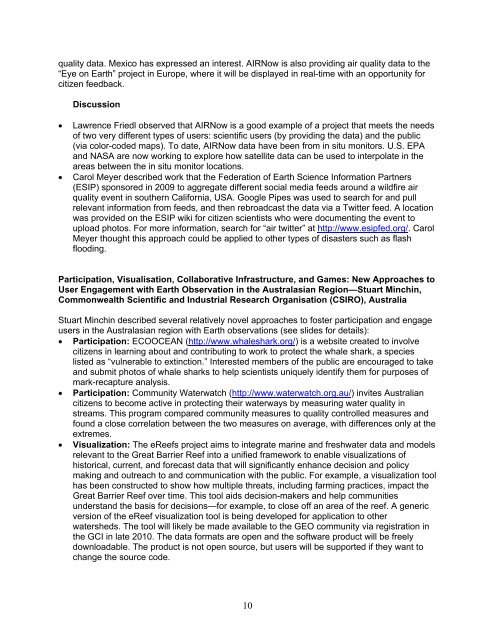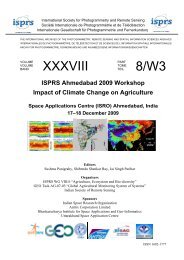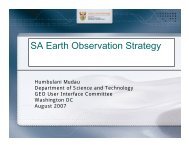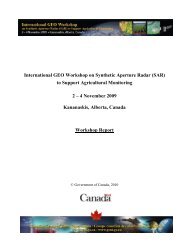GEO UIC Committee: - Group on Earth Observations
GEO UIC Committee: - Group on Earth Observations
GEO UIC Committee: - Group on Earth Observations
You also want an ePaper? Increase the reach of your titles
YUMPU automatically turns print PDFs into web optimized ePapers that Google loves.
quality data. Mexico has expressed an interest. AIRNow is also providing air quality data to the<br />
“Eye <strong>on</strong> <strong>Earth</strong>” project in Europe, where it will be displayed in real-time with an opportunity for<br />
citizen feedback.<br />
Discussi<strong>on</strong><br />
• Lawrence Friedl observed that AIRNow is a good example of a project that meets the needs<br />
of two very different types of users: scientific users (by providing the data) and the public<br />
(via color-coded maps). To date, AIRNow data have been from in situ m<strong>on</strong>itors. U.S. EPA<br />
and NASA are now working to explore how satellite data can be used to interpolate in the<br />
areas between the in situ m<strong>on</strong>itor locati<strong>on</strong>s.<br />
• Carol Meyer described work that the Federati<strong>on</strong> of <strong>Earth</strong> Science Informati<strong>on</strong> Partners<br />
(ESIP) sp<strong>on</strong>sored in 2009 to aggregate different social media feeds around a wildfire air<br />
quality event in southern California, USA. Google Pipes was used to search for and pull<br />
relevant informati<strong>on</strong> from feeds, and then rebroadcast the data via a Twitter feed. A locati<strong>on</strong><br />
was provided <strong>on</strong> the ESIP wiki for citizen scientists who were documenting the event to<br />
upload photos. For more informati<strong>on</strong>, search for “air twitter” at http://www.esipfed.org/. Carol<br />
Meyer thought this approach could be applied to other types of disasters such as flash<br />
flooding.<br />
Participati<strong>on</strong>, Visualisati<strong>on</strong>, Collaborative Infrastructure, and Games: New Approaches to<br />
User Engagement with <strong>Earth</strong> Observati<strong>on</strong> in the Australasian Regi<strong>on</strong>—Stuart Minchin,<br />
Comm<strong>on</strong>wealth Scientific and Industrial Research Organisati<strong>on</strong> (CSIRO), Australia<br />
Stuart Minchin described several relatively novel approaches to foster participati<strong>on</strong> and engage<br />
users in the Australasian regi<strong>on</strong> with <strong>Earth</strong> observati<strong>on</strong>s (see slides for details):<br />
• Participati<strong>on</strong>: ECOOCEAN (http://www.whaleshark.org/) is a website created to involve<br />
citizens in learning about and c<strong>on</strong>tributing to work to protect the whale shark, a species<br />
listed as “vulnerable to extincti<strong>on</strong>.” Interested members of the public are encouraged to take<br />
and submit photos of whale sharks to help scientists uniquely identify them for purposes of<br />
mark-recapture analysis.<br />
• Participati<strong>on</strong>: Community Waterwatch (http://www.waterwatch.org.au/) invites Australian<br />
citizens to become active in protecting their waterways by measuring water quality in<br />
streams. This program compared community measures to quality c<strong>on</strong>trolled measures and<br />
found a close correlati<strong>on</strong> between the two measures <strong>on</strong> average, with differences <strong>on</strong>ly at the<br />
extremes.<br />
• Visualizati<strong>on</strong>: The eReefs project aims to integrate marine and freshwater data and models<br />
relevant to the Great Barrier Reef into a unified framework to enable visualizati<strong>on</strong>s of<br />
historical, current, and forecast data that will significantly enhance decisi<strong>on</strong> and policy<br />
making and outreach to and communicati<strong>on</strong> with the public. For example, a visualizati<strong>on</strong> tool<br />
has been c<strong>on</strong>structed to show how multiple threats, including farming practices, impact the<br />
Great Barrier Reef over time. This tool aids decisi<strong>on</strong>-makers and help communities<br />
understand the basis for decisi<strong>on</strong>s—for example, to close off an area of the reef. A generic<br />
versi<strong>on</strong> of the eReef visualizati<strong>on</strong> tool is being developed for applicati<strong>on</strong> to other<br />
watersheds. The tool will likely be made available to the <str<strong>on</strong>g>GEO</str<strong>on</strong>g> community via registrati<strong>on</strong> in<br />
the GCI in late 2010. The data formats are open and the software product will be freely<br />
downloadable. The product is not open source, but users will be supported if they want to<br />
change the source code.<br />
10







